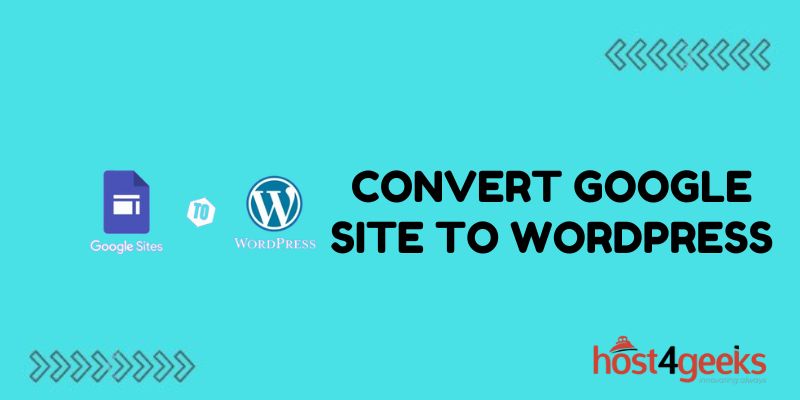Google Sites is a handy web hosting platform for basic websites, but its simplicity can become limiting over time. If your Google Site has hit a wall with what’s possible for features, customizations, or performance? Not ready to give up your investment in content creation but hungry for better tools?
Then like many webmasters before you, consider migrating your Google Site content over to the wildly popular WordPress platform. While moving between web hosts sounds risky, WordPress opens far more growth potential for small to large websites alike.
Armed with the right migration approach, converting your existing Google Site to leverage WordPress as your new foundation can pay off tremendously despite some upfront effort. Ready to learn how to make this switch smoothly?
In this guide, we’ll walk through everything you need to know to convert your Google Site to WordPress.
Evaluate Your Google Site Content
Before deciding to switch to WordPress, take stock of your existing Google Site and how you use it. Ask questions like:
- What content do you have and how is it organized?
- Who visits your site and what do they use it for?
- Do you mostly use basic text pages or more complex features like calendars and embedded media?
Knowing how your site is structured and used will help plan the WordPress equivalent.
Choose Your WordPress Hosting
Once you decide WordPress is the right move, the next key step is choosing where to host it. Some top options include:
- Managed WordPress hosting like WP Engine provides optimized WordPress hosting. This simplifies setup but costs more.
- Shared hosting plans from companies like Bluehost are more affordable but require more technical know-how.
- WordPress.com is WordPress’ free, limited hosting option. Upgrades unlock more features.
Think about your budget, needs, and technical skills when deciding on hosting.
Install WordPress and Themes
With hosting set up, it’s time to install WordPress using either:
- The control panel from your host for things like cPanel or Plesk.
- The auto-installer from hosts like WP Engine and SiteGround handles this automatically.
Once WordPress is installed, customize things further by choosing a WordPress theme that matches your site goals. Take themes for a test drive by activating and deactivating them to see what works best.
Set Up Pages and Menus
Now shift your focus to properly configuring WordPress by:
- Creating pages to match existing content from your Google Site. Install page builder plugins as needed to replicate more complex page elements.
- Building site menus and navigation so visitors can easily move between sections just like they could on your old Google Site. Take time to thoughtfully organize pages and navigation.
Import Content from Google Sites
Rather than copy-pasting content from Google Sites, use a dedicated Google Sites to WordPress importer tool instead. Some top options include:
- BlogVault offers a robust import that brings over pages, attachments, metadata, URLs, and more directly into WordPress.
- Plugins like Google Sites Importer pull text and image content from Google Sites to corresponding pages or posts in WordPress.
Migrating content programmatically reduces manual effort so focus stays on recreating the site experience.
Add Plugins and Enhance Functions
While WordPress itself offers solid built-in features, extending things further through plugins opens up more advanced options like:
- SEO plugins for improving search optimization and integrations. Yoast SEO is a top free choice.
- Form and survey plugins to recreate any feedback and data collection features from your old Google Site. Consider WPForms or Contact Form 7.
- E-commerce plugins such as WooCommerce if you need to recreate an online store from your Google Site.
Take time to browse the expansive WordPress plugin library for anything your site needs.
Configure Settings and Launch
With all your content, pages, navigation, and features ready to go, wrap up by:
- Defining site settings like your tagline, site language, URL structure preferences, and more.
- Handling redirects from old Google Site pages to corresponding new WordPress URLs so visitors land in the right places.
- Going live by switching the site to a public viewable mode versus previous development or maintenance mode status.
- Monitor traffic and site performance at launch to squash bugs and identify improvements to drive future iterations.
Maintain and Expand Your Site
With the site successfully transitioned from Google Sites to WordPress, ongoing maintenance like:
- Regular content updates through new blog posts and page additions.
- Plugin and theme updates to address vulnerabilities, add features, and improve integration with new WordPress releases.
- Backups and security monitoring through available WordPress-focused security services.
- Performance optimization by using tools like caching plugins to support increased traffic.
Will help your WordPress site continue growing while avoiding major incidents.
Key Takeaways When Switching from Google Sites
Migrating to WordPress takes planning but brings much added flexibility and customization potential. Keeping the following best practices in mind will help:
- Assess content and structure before deciding on WordPress. Be realistic about how feasible reproducing all features will be.
- Consider managed WordPress hosting to simplify the technical aspects, especially for larger, more complex sites.
- Use import tools to automate bringing content from Google Sites into WordPress.
- Take it slowly by transitioning in stages versus all at once if it is a very large Google Site.
By understanding the differences between the two platforms, strategically moving content from one to the other, and leveraging help where needed, Google Sites users can successfully convert to WordPress as their new long-term site home.
In Closing
Transitioning web hosting platforms is rarely quick or painless. But for those looking for expanded features and customizations beyond what Google Sites can provide, converting to WordPress is worth the effort.
With some upfront planning and patience during the migration itself, the benefits of flexibility and ownership over your site’s capabilities make WordPress an ideal publishing solution for the long haul.
